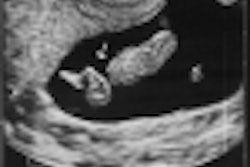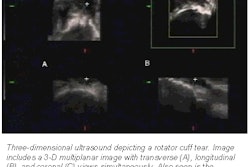
The ultrasound division of Siemens Medical Solutions today unveiled a new platform for its Sonoline ultrasound family. Called Antares, the new portable system will join Elegra as the Issaquah, WA-based firm's new mid-priced premium ultrasound scanner.
Siemens believes the system's small size (a 24-x-39-inch, 406-lb footprint) and premium image quality will strike a chord in the marketplace. The vendor also points to Antares' ergonomic design as a distinguishing factor.
The product is designed primarily for general imaging, high-risk ob/gyn, and vascular imaging applications, said Doug Whisler, director of marketing, emerging markets. The scanner will range in price from $150,000 to $200,000, depending on configuration.
Antares includes familiar Siemens technology, in the form of its Crescendo multidimensional image processor, Ensemble tissue harmonic imaging, Multi-D array transducer technology, and wideband MultiHertz multiple frequency imaging. But the scanner also employs several new image acquisition and processing features.
Siemens' new maximum information signal acquisition (MISA) beamformer concept makes use of what the company calls high-density active aperture technology, which provides a wider simultaneous transducer aperture, Whisler said. Siemens said its channel-per-signal architecture, in concert with high-density active aperture, achieves a one-to-one relationship between all transducer elements and the machine's actual processing channels.
"It has eliminated the need for synthetic aperture, but [still] maintains high density of information coming in," he said. "There's no need for multiplexing or switching required in the beamformer."
Another technology, called precision up-sampling, quickly samples the basic radio-frequency signals early in the imaging chain, creating what Siemens says is a near-perfect representation of the analog waveform, Whisler said. "What we've created is almost a digital photocopy of the returning echo," he said.
The vendor's SieScape panoramic imaging will also be available as an option on Antares.
In development since 1999, Antares also makes use of technology contributed by Acuson, which Siemens acquired late last year. The companies have married Acuson's DIMAQ workstation with Siemens' Crescendo multidimensional image processor. The integrated workstation, called DIMAQ-IP, provides seamless communication between the system's internal architecture and external archiving and review stations, according to the firm.
In coming months, Siemens will also add more Acuson capabilities to the scanner, notably the Mountain View, CA-based firm's tissue equalization technology (TEQ), Whisler said. He declined to comment on a timeline for migration.
Siemens believes sonographers will also appreciate the ergonomic features of Antares, thanks to what the vendor calls its ErgoDynamics system design. "[Sonographers] have a high rate of injury from repetitive stress or muscular strain," he said. "This system was developed to minimize those repetitive motions."
ErgoDynamics facilitates the creation of two work zones, which Siemens calls the natural reach zone and the extended reach zone. All of the scanner's major system controls are on the same plane, minimizing the amount of stretching, bending, and reaching required.
The scanner's operator can also easily check the operation of components such as the printer and video recorder during the course of the exam, without having to change position, he said. The system can also be easily moved closely to the bed, helping the sonographer avoid reaching too far to scan a patient.
The relationship between the control panel and monitor is fixed, so when monitor and control panel are adjusted, sonographers can still attain the ideal ergonomic relationship, he said. Antares also comes equipped with lightweight cables and transducers, as well as a wrist support.
The use of Siemens' syngo common modality user interface also confers workflow and productivity benefits, according to the firm. Syngo makes the control panel and user interface adaptive to the operator's workflow, Whisler said. "When you're imaging, the system anticipates the operator's needs by setting up the next sequence," he said.
Antares employs multiple Intel processors and the Windows NT operating system, allowing the system to easily add future applications as they become available. Siemens has also integrated many individual components into custom and programmable application-specific integrated circuits (ASIC), allowing for much fewer electronic interconnections. This allows for increased system reliability, shorter signal path, and improved signal-to-noise ratio, Whisler said.
Siemens has begun production of Antares and expects to begin shipments later this month. While Antares and Elegra (ranging from $150,000 to $230,000, depending on configuration) share similar price points, Siemens expects the systems to appeal to different users. Antares might be of interest to customers seeking a particularly mobile scanner, while prospective purchasers looking for advanced imaging features such as 3-D might choose Elegra, Whisler said.
"Elegra will continue, and in fact, we're introducing a new software release for Elegra later this year, migrating features potentially from the Sequoia platform," he said. "The Elegra platform will continue until the market decides it's no longer of value."
By Erik L. Ridley
AuntMinnie.com staff writer
July 16, 2001
Click here to post your comments about this story. Please include the headline of the article in your message.
Copyright © 2001 AuntMinnie.com




















